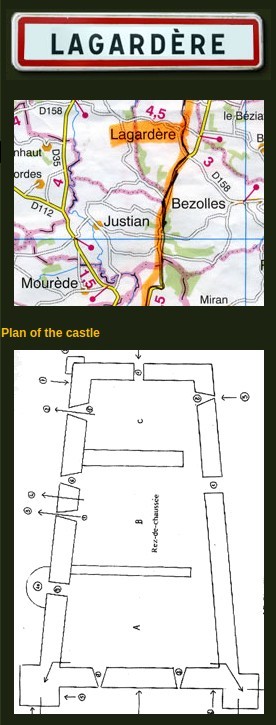
 Lagardère castle stands a few meters to the west of the village of the same name, just a few kilometers north of Vic-Fezensac. A small chapel nearby adds a touch of charm to the setting.
Lagardère castle stands a few meters to the west of the village of the same name, just a few kilometers north of Vic-Fezensac. A small chapel nearby adds a touch of charm to the setting.
As the castle’s name indicates –celle qui garde (“she who guards”)—its position is one of height and dominance and affords a magnificent panoramic view of the surrounding region. This strategic position enabled the castle to keep watch over the valley of the Osse and to keep watch over the countryside to the northwest all the way to Eauze.
In fact, Lagardère is one of the rare Gascon chateaux whose construction can actually be dated, which is exceptional. The first known written reference to the site is an act from 1270 by which Count Géraud V of Armagnac ceded the lands of Lagardère to Auger, abbey of Condom, and his monks. The terms of the act stipulate that the abbey and his successors “may construct, erect a fortified structure, fortress, house or any other edifice including a fortified town…on the site and territory named La Gardère. The count reserving for himself and his successors the right to have his men occupy, whenever circumstances should justify it, the fortified structure to be built.”
The castle is built on a trapezoidal plan: 28 meters long by 12 meters wide on once side, 10 meters on the other. The walls are massive, with a thickness of 1.5 meters.
Originally, the castle took the form of a massive, three-story dwelling structure flanked by two turrets, devoid of any interior courtyard, and with a ground floor without almost any openings.
For Philippe Lauzun “Its particularity from an archeological point of view is that, judging from its state of conservation, it allows one to see right away the purpose proposed by its architect and the measures undertaken…for attack and defense.” More, “it is the most revealing as to the guiding directive that presided over its construction. Indeed, in six hundred years, nothing has destroyed or even modified its original layout.”
However, this supposed architectural integrity is strongly questioned by René Caïrou, who has noted remodeling in the fourteenth and sixteenth centuries, and by Christian Corvisier, who situates all these revocations in the sixteenth century.
As for Jacques Gardelles, he takes the middle road, saying that “it’s a typical Gascon chateau in the sense that it has undergone little remodeling.”
Chateau Lagardère has been the object of at least three detailed architectural studies, and Lauzun devoted an entire monograph to it in 1894. René Caïrou studied the castle in 1986 in his book on Architecture militaire des XIIIe et XIVe siècles, and Christian Corvisier presents an analysis and a reconstitution of the missing parts of the edifice’s structure on the internet site of the Association Lagardère.
The Association Lagardère, which represents a number of families of the same name, has undertaken some remarkable restoration and excavations of the site. One can find on their internet site a complete description of the castle along with all the hypotheses regarding its transformation until its abandonment towards the turn of the eighteenth and nineteenth centuries. To be compared with the publications of Lauzun and Caïrou…
We cannot close our presentation of Lagardère without mentioning to fans of cape and sword novels that the castle unfortunately has nothing to do with the Hunchback immortalized by the writer Paul Féval and his famous line “If you don’t come to Lagardère, Lagardère will come to you”.
However, even today, looking up at the castle takes us back to that time of cape and sword.
